On Sunday March 17th, 2024, Chase Krumholz and I played with some ski alpinism tactics – linking a climb of the famous Irene’s Arete (5.8, III) with ski descent of the classic Spoon Couloir on Disappointment Peak. Rock climbing with skis – get weird!
(Many of the tactics discussed in this article involve using certain pieces of climbing equipment outside their intended purpose. This is an entirely personal decision that should be self informed, is not encouraged, and could be very dangerous.)
I’m sure others have pursued such shenanigans pre-2020, but it was local EXUM guide Michael Gardner’s visionary linkup of the Grand Teton’s Complete Exum Ridge (5.7, IV) with a summit ski descent of the Ford Couloir in March 2020 that put ski alpinism, or “climb-to-ski”, on my radar. This early winter Gardner and company threw a second lap on the same linkup, just one day before a partner and I got cold feet on our own Complete Exum-Ford Couloir bid. Despite days of intense planning we never even left the lot, because well… it’s quite simply pretty damn intimidating. I’ve long fancied multi-sport activities, and ever since I delved deep into technical ice and winter mixed climbing I’ve been dreaming of ways to combine icy ascents with technical ski descents. Merging dry rock climbing with skiing came a little later, born from Gardner’s energy shifting the lens with which I observed my winter ski landscape. By March, the longer days and generally higher temperature swings melt out the steepest south facing walls of Grand Teton National Park, and any rock climber who has gone on a bluebird, windless, high pressure springtime tour has thought to themselves at least once: “Wow, it’s so hot. We could climbing right now.” Winter ascents have a long standing tradition in North American mountaineering, defined as the ascent of a route or peak between the winter solstice and spring equinox. And while it might seem a little loopy to drag skis and boots up a mulit-hundred foot vertical rock face, they are certainly the most efficient, and fun, tool for descent. With advancements in modern skiing and climbing gear, weight is becoming increasingly less of an issue, especially for those willing to stretch the limitations of certain tools beyond their intended purpose. All in all, I’m guessing my pack weighed somewhere around 20-25 pounds when we tied into the first pitch of Irene’s Arete (5.8, III), a bit hefty, yet nothing entirely unreasonable for 5.8 rock climbing. All these reasons, amplified by a thirst for a raw, all encompassing mountain adventure, landed Chase and I at the base of Irene’s, skis in tow, staring down 800 feet `of intimidating vertical granite on a warm March 17th, 2024. “Let’s see how this goes” I said, and started off on lead.

Our day began at 7:30AM – a casual start, but we figured at least an hour of sun on the southeast facing wall would be pertinent before tying in. In the days preceding we trimmed our kit down to the bare essentials. I wore my carbon Scarpa F1 ski boots and Moonlight Mountain Gear 90mm Northern Lights carbon skis with Black Diamond Helio 180 race bindings. Chase rocked the same boots with slightly heavier skis, making up the weight difference given his height and subsequent shorter gear. Avalanche equipment stayed at home, and our non-climbing goods consisted of a lightweight puffy and rain shell each, two pairs of light gloves each, one liter of water each, weight conscious snacks, an anemic med kit of two ace bandages, climbing tape, Ibuprofen and an emergency bivy, and one satellite phone. We both brought climbing helmets, ski-mo rappel harnesses, small chalk bags, crack gloves and an oversized pair of rock shoes. We climbed on two 60 meter, 6 millimeter, Edelrid Rap Lines. Our rack was about as light as feasible – a single set of Metolius ultralight cams from #1 (blue, thin fingers) to #8 (purple, large hands), one black Totem Cam, ten assorted wires, eight alpine draws, one 60cm Dyneema sling for use as a gear sling and two 240cm Dyneema slings for anchors. We would lead belay on an Edelrid Micro-Jul paired with the fattest carabiner possible (for extra assisted braking), and belay from the top with a Black Diamond Alpine ATC paired with two wiregate carabiners for additional friction. A Metolius ultralight nut tool and one personal locker each rounded out the lot. For 800 feet of pitched rock climbing up to 5.8, this was about the slimmest system for our abilities. Reaching the base turned out to be no small feat, pushing our estimated 10:30AM launch to 12:15. A soft freeze rendered the snowy ledges defending the base of the route heinously isothermal, requiring extensive vegetated mixed climbing, tree hand-lining and sanity threatening post-holing that almost nudged me towards skipping the first two pitches, easily done via a broad ledge system. Thankfully Chase talked some sense into me – we didn’t come this far for an asterisk ascent.

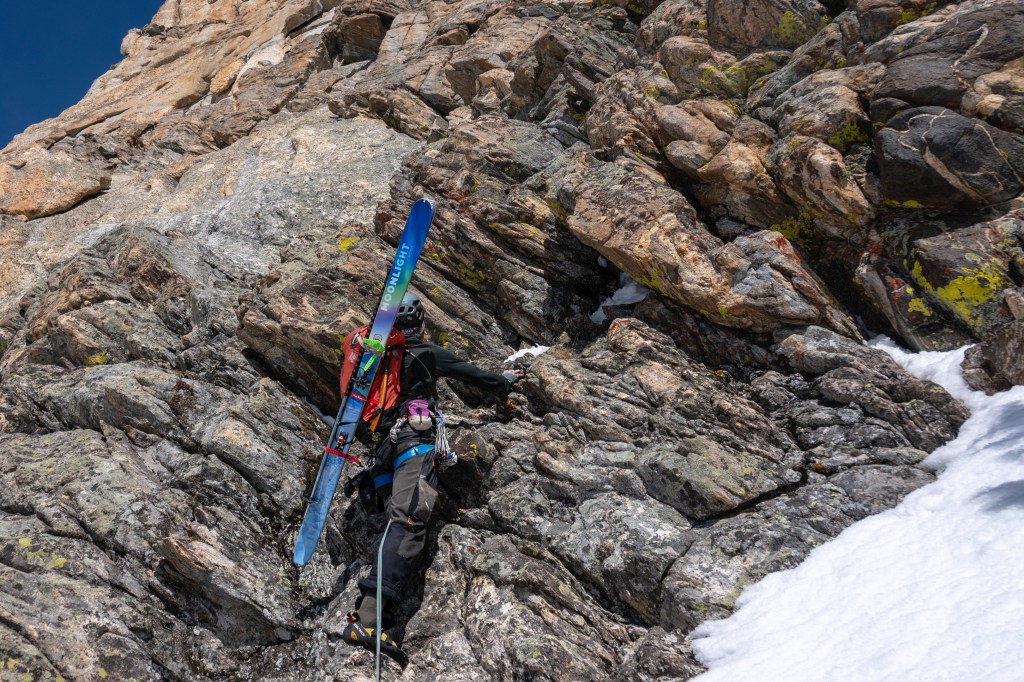

Irene’s has many variations from 5.8 to 5.10, but our plan was to stalk the path of least resistance. I led the first pitch, a left trending 5.6 slab and corner system ending beneath a golden inverted “tooth” that marks the 5.8 crux of the route, a bulging hand and fist crack. The protrusion looked ferocious for skis, the tooth forming a mini-roof that seemed to require committing overhanging jams, so luckily I was able to bypass it on the right with an unprotected 5.7 face traverse to a fixed anchor on a tiny ledge. Chase took the next lead, a short pitch of rambling terrain to a large ledge beneath the keynote steep arete pitches hanging daringly overhead. We were both amazed that this whole “climbing with skis thing” was actually working, but only had we now met the meat of the business.
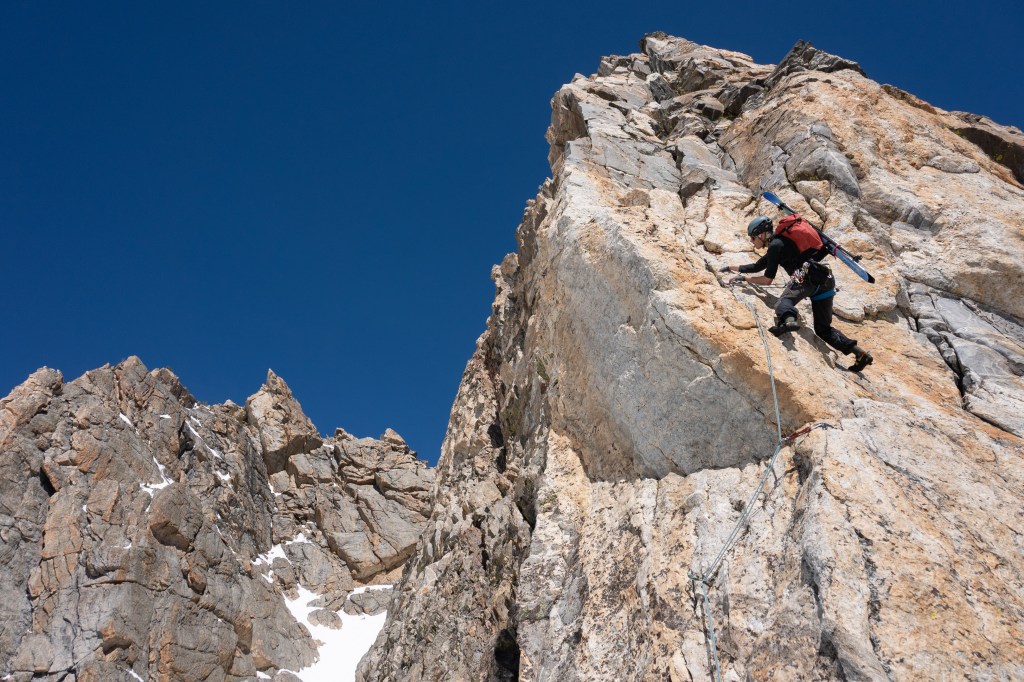
Our third (traditionally second) pitch my very well be the best of Irene’s, forty meters of crack, slab and blocky corner questing on either side of the exposed crest. Given our trim rack I was regularly running the rope 5-7 meters between pieces, a novel feeling amidst a winter landscape with skis on my back – let’s just say I was pulling a little harder than usual. Near the end of this pitch the route trends west into a shaded left-facing corner with an overhanging right wall. Here Chase and I learned our first of many lessons about rock climbing with skis – the direction your skis face on your pack can make or break the difficulty, or lack thereof, of corner, roof and chimney climbing. In vertical carry mode my skis hung over my right shoulder, causing the tips to bang into, and scrape against, the right wall of the pitch three dihedral. This made my lead particularly awkward and difficult, while Chase followed with relative ease, ski tips oriented over his left shoulder.

The crux of our day was the beginning of pitch four – Chase’s lead – a leftward slabby traverse immediately off the belay, with marginal hands and small gear in a seam at ankle height providing little security from a ground fall. With a little flash spray from yours truly Chase dispatched the work handily, and ran the rope a full 50 meters to the top of our final difficult pitch. Two more leads on moderate rock followed, each 5.7, the former on the iconic shark fin of the upper arete and the latter the easiest of three variations out of a snowy notch that required delicate talus hopscotch to keep our shoes dry. The only wetness on the entire climb occurred 30 meters from the top, where a matrix of east facing lichened slabs were streaked with water, ice or both, beckoning extra attention to footholds, and the occasional long reach. We topped out around 5:00PM, about three hours and forty five minutes after tying in. The view from the summit, augmented by a strong feeling of accomplishment and the afterglow of deep fatigue, was a spectacle of late evening yellows, oranges and crimson. Chase captured the scene diligently with his camera. I took less pictures. My hummus sandwich tasted especially delicious. We had reached the pantheon.

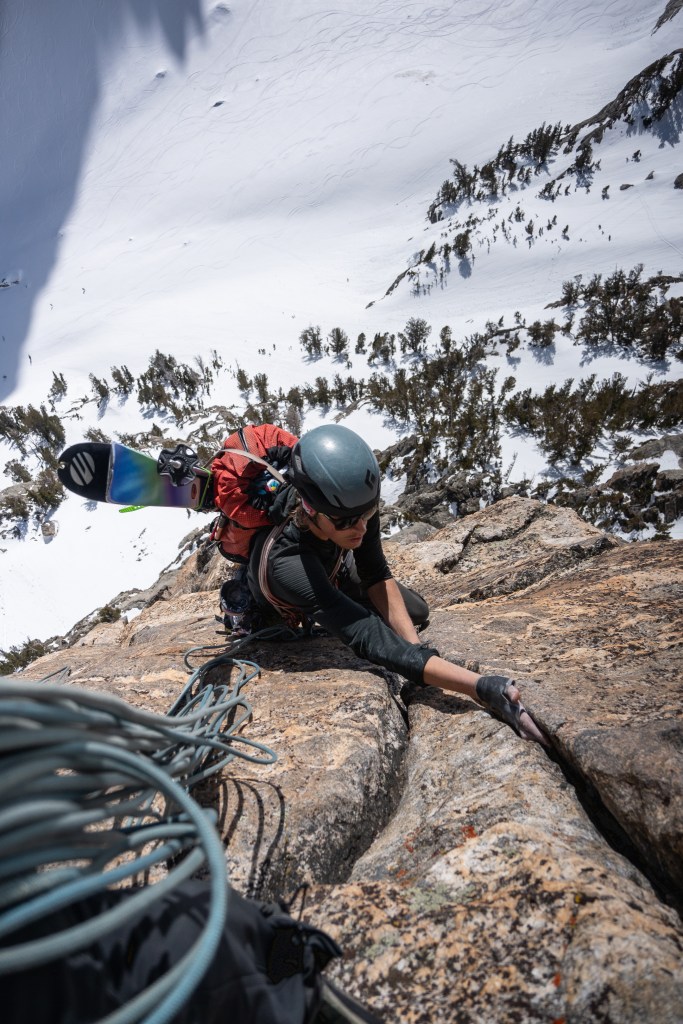


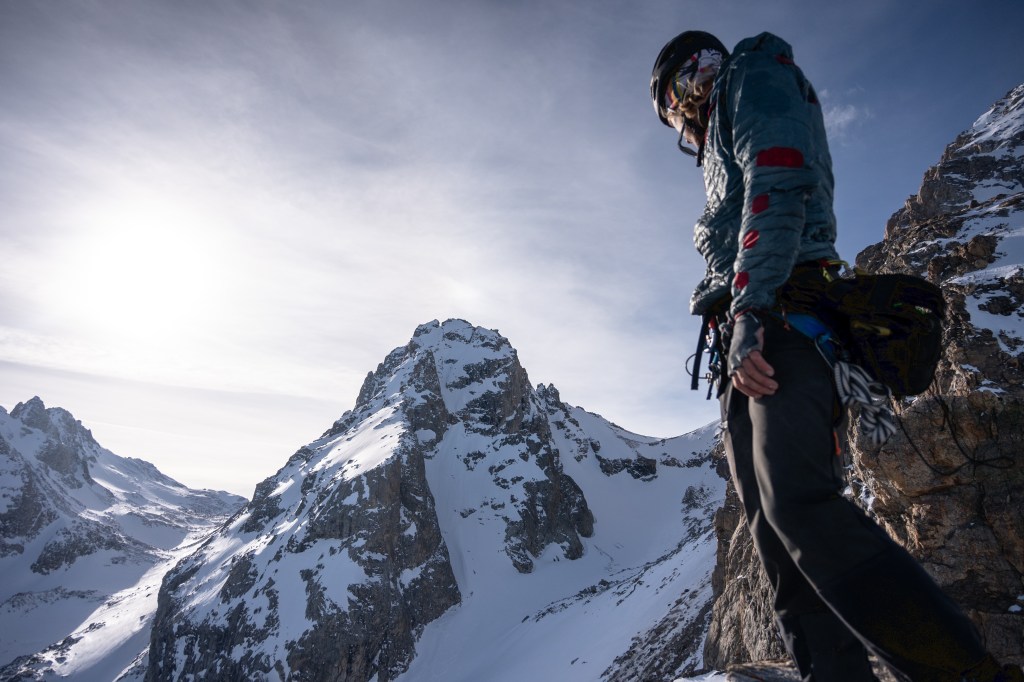
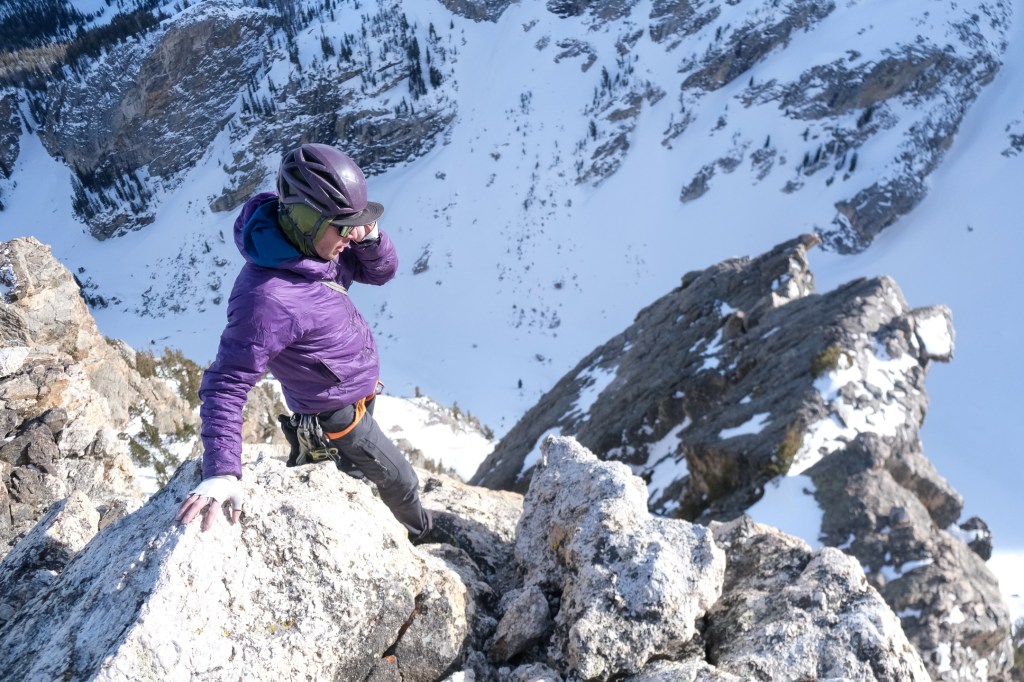
We took a style dock by forgoing the summit of Disappointment Peak in favor of daylight, sliding into the Spoon Couloir just before 6:00PM. The line had avalanched as early as that afternoon, leaving behind a bed surface of East Coast glass and the occasional pocket of north facing powder. My carbon toothpicks performed better than expected, and the turns, though horrible by any other standards than grateful climbers on testy long link-up, produced many hoots and hollers. Returning to Bradley Lake was misery to the tenth degree – refrozen mashed potatoes with heavy packs – we won’t go there. We reached the car without headlamps at 7:00PM.
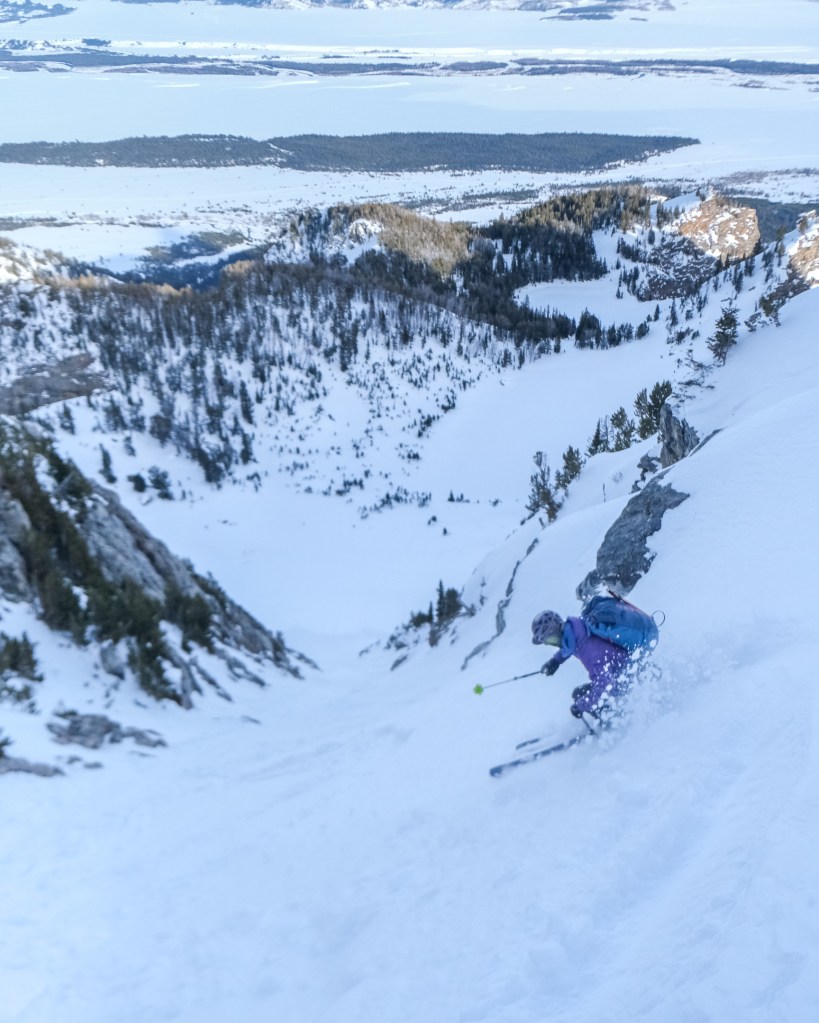
Reflection
Most mountain athletes would consider climbing Irene’s Arete with skis a fool’s activity. However, for the right personality with a diverse vertical skillset it could be considered classic. For both Chase and I, a winter ascent of Irene’s linked with a ski descent of the Spoon Couloir was a groundbreaking personal challenge – mutually agreed to be one of the finest days either of us have ever had in the mountains. Ultimately, rock climbing with skis wasn’t nearly as difficult as we’d imagined, with weight being the biggest hinderance rather than the actual planar space taken up by the skis themselves. However, we were both surprised how physically gassed we were at the top of the route – I only climb 5.10+, but for 5.13 Chase that sentiment speaks to the difficulty of adding 20-25 pounds to one’s shoulders on vertical rock above 10,000 feet. The route itself is the perfect choice winter rock climbing. The absence of large ledges, sustained steepness and exposed southeast aspect kept the route almost entirely free of snow, water and ice. I prepared for a much colder battle, but had the skis and snowpants vanished I would have thought it mid-July. Above all else, the feeling of climbing a splitter #0.5 Camalot crack with skis on your back, locking off on a good jam and arching your back over the snow clad Meadows below, amidst an amphitheater of plastered mid-winter granite peaks in every direction, promotes a visceral sense of adventure. Like few days I’ve had before, I felt like a free and wild creature. Tack on 800 feet of 45 degree couloir jump turns and the scene paints itself. This was a great day – and perhaps the diving board for many more. We believe this was the first time this link-up has been done in the Teton Range.
A Few Last Notes On Ski Alpinism Tips
- The direction skis face on your back can make or break the difficulty of a corner, roof or stem chimney pitch. Off-widths and tight chimneys are obviously basically impossible and should be avoided. On Irene’s, skis facing over the left shoulder will fare best. I am hoping to modify my pack this spring to allow different ski orientations over either shoulder that can be adjusted before each pitch.
- Racking for lead on a gear sling (we used a 60cm Dyneema sling) is very useful, as the gear loops on ski-mo rappel harnesses are often small and difficult to access with oversized loads on your back.
- Crack gloves weigh almost nothing and help to insulate the hands while jamming cold cracks.
- Plastic grocery bags can be used as liners/gaiters outside of socks, to protect socks if snow is encountered.
Ten Thousand Too Far is supported by Icelantic Skis, Range Meal Bars and Black Diamond Equipment.
Ten Thousand Too Far is also supported by reader donations. If you’ve used this website to plan an epic adventure, consider kicking in a few bucks. The hours spent writing these articles are fueled solely by the desire to enhance our vertical community.

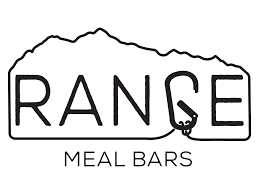

DISCLAIMER
Ski mountaineering, rock climbing, ice climbing and all other forms of mountain recreation are inherently dangerous. Should you decide to attempt anything you read about in this article, you are doing so at your own risk! This article is written to the best possible level of accuracy and detail, but I am only human – information could be presented wrong. Furthermore, conditions in the mountains are subject to change at any time. Ten Thousand Too Far and Brandon Wanthal are not liable for any actions or repercussions acted upon or suffered from the result of this article’s reading.
